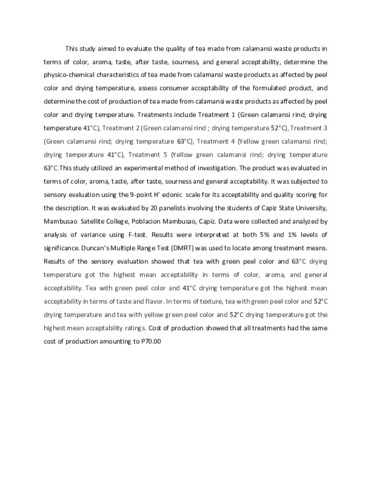Processing and utilization of Calamansi (Citrofortunella microcarpa) waste products in tea production
| dc.contributor.advisor | Hilapad, Marife R. | |
| dc.contributor.author | Nimes, Joselito Jr. O. | |
| dc.contributor.author | Olano, Mark C. | |
| dc.contributor.author | De Juan, Ronnie | |
| dc.date.accessioned | 2024-03-25T05:37:30Z | |
| dc.date.available | 2024-03-25T05:37:30Z | |
| dc.date.issued | 2022-06 | |
| dc.identifier.citation | Nimes, J.O., Olano, M.C., & De Juan, R. (2022). Processing and utilization of Calamansi (Citrofortunella microcarpa) waste products in tea production [Undergraduate thesis, Capiz State University Mambusao Satellite College]. CAPSU Institutional Repository. | en |
| dc.identifier.uri | https://repository.capsu.edu.ph/handle/123456789/239 | |
| dc.description.abstract | This study aimed to evaluate the quality of tea made from calamansi waste products in terms of color, aroma, taste, after taste, sourness, and general acceptability, determine the physico-chemical characteristics of tea made from calamansi waste products as affected by peel color and drying temperature, assess consumer acceptability of the formulated product, and determine the cost of production of tea made from calamansi waste products as affected by peel color and drying temperature. Treatments include Treatment 1 (Green calamansi rind; drying temperature 41°C), Treatment 2 (Green calamansi rind ; drying temperature 52°C), Treatment 3 (Green calamansi rind; drying temperature 63°C), Treatment 4 (Yellow green calamansi rind; drying temperature 41°C), Treatment 5 (Yellow green calamansi rind; drying temperature 63°C.This study utilized an experimental method of investigation. The product was evaluated in terms of color, aroma, taste, after taste, sourness and general acceptability. It was subjected to sensory evaluation using the 9-point H’ edonic scale for its acceptability and quality scoring for the description. It was evaluated by 20 panelists involving the students of Capiz State University, Mambusao Satellite College, Poblacion Mambusao, Capiz. Data were collected and analyzed by analysis of variance using F-test. Results were interpreted at both 5% and 1% levels of significance. Duncan’s Multiple Range Test (DMRT) was used to locate among treatment means. Results of the sensory evaluation showed that tea with green peel color and 63°C drying temperature got the highest mean acceptability in terms of color, aroma, and general acceptability. Tea with green peel color and 41°C drying temperature got the highest mean acceptability in terms of taste and flavor. In terms of texture, tea with green peel color and 52°C drying temperature and tea with yellow green peel color and 52°C drying temperature got the highest mean acceptability ratings. Cost of production showed that all treatments had the same cost of production amounting to P70.00 | en |
| dc.language.iso | en | en |
| dc.publisher | Mambusao Satellite College, Capiz State University | en |
| dc.subject | Tea | en |
| dc.subject | Calamansi peel | en |
| dc.subject | Analysis of Variance (ANOVA) | en |
| dc.subject | Waste products | en |
| dc.subject.lcsh | Waste products | en |
| dc.subject.lcsh | Waste products -- Recycling | en |
| dc.title | Processing and utilization of Calamansi (Citrofortunella microcarpa) waste products in tea production | en |
| dc.type | Thesis | en |
| dc.contributor.chair | Hilapad, Marife R. | |
| dc.contributor.committeemember | Garcia, Clyde Dwynelh O. | |
| dc.contributor.committeemember | Ticar, Rhodora L. | |
| thesis.degree.discipline | Food Technology | en |
| thesis.degree.grantor | Capiz State University Mambusao Satellite College | en |
| thesis.degree.level | Undergraduate | en |
| thesis.degree.name | Bachelor of Science in Food Technology | en |
| dc.subject.agrovoc | Tea | en |
| dc.subject.agrovoc | Calamansi peel | en |
| thesis.degree.department | Food Technology Department | en |
| dc.subject.scientificname | Citrofortunella microcarpa | en |

